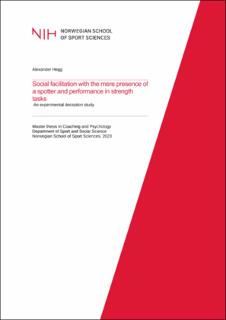| dc.description.abstract | Purpose: Sheridan et al. (2019) found that presence of passive spotters facilitated performance enhancements during bench press, enhanced self-efficacy levels, and reduced their rate of perceived exertion compared to without spotter. Sheridan et al. (2019) recommended that future research should investigate presence of spotters on different resistance exercises, and the social interaction between the spotters and participants. This study aimed to explore the impact of social facilitation on strength-related task and examine how individual trait and state anxiety levels can influence performance. Using an isokinetic dynamometer, effect of spotter presence during different approaches was investigated in both squat and bench press performance.
Methods: Twelve recreationally trained students (age, 22.4 ± 1.9 years, height, 172.1 ± 12.1 cm, and weight, 70.5 ± 13.4 kg) performed 3 trials of 2RM, 1RM, and 10RM on separate occasions in an experimental deception study. The 3 trials consisted of a spotter being passive (PS), a spotter being supportive with verbal encouragement (SS), or an alone condition (NS) (spotter hidden from view). During the trials, peak and mean force for each repetition range on both exercises and state anxiety were measured.
Results: In SS compared to NS, the group increased their 1RM squat peak force (M = 223.6 N, 95% CI [143.3, 303.8], p = .001, 𝜂𝑝2 = .881), and mean force (M = 94.1 N, 95% CI [31.3, 156.9], p = 0.004, 𝜂𝑝2= .713). The 10RM testing also revealed increases in peak force (M = 166.5 N, 95% CI [51.5, 281.5], p = .005, 𝜂𝑝2= .616) and mean force (M = 81.3 N, 95% CI [10.3, 152.2], p = .024, 𝜂𝑝2 = .512) in SS compared to NS. In terms of spotter effects, the male participants received the highest performance improvements.
Conclusion: For recreationally trained individuals, the presence of a supportive spotter increases squat performance in both peak and mean force during 1RM and 10RM compared to the alone condition. The information gained from this study suggests that researchers, strength coaches, and personal trainers should recognize the importance of verbal encouragement and the presence of a spotter during testing to optimize performance or the necessity for standardization to ensure consistency. | en_US |
